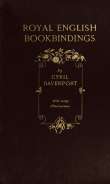You are here
قراءة كتاب Royal English Bookbindings
تنويه: تعرض هنا نبذة من اول ١٠ صفحات فقط من الكتاب الالكتروني، لقراءة الكتاب كاملا اضغط على الزر “اشتر الآن"
with the words used by Elizabeth in her dedication, and the two H’s, worked in a thick red silk cord with a silver thread in it, which are above and below the monogram, supply the needful name. I do not know that this interpretation is by any one considered to be the right one, but it appears to me at all events as plausible as any of the others I have heard. At each corner is a heartsease of purple and gold and small green leaves. This most curious and interesting binding is in many ways nearly allied to that made for Queen Katharine Parr, which is now at the Bodleian Library at Oxford, and which I shall presently describe. This binding is also considered to be the work of the Princess Elizabeth, and I think that the similarity in the peculiar groundwork, the identity of the pansies in the corners, and the use of braid or very thick thread in each, producing a maximum of effect with a minimum of labour, are all strong reasons for believing that both volumes are the work of the same hand, namely, that, of the Princess herself.

Deloenus. Libellus de tribus Hierarchiis, etc., MS. Henry VIII.
The Bodleian binding is in very fair condition, but the British Museum one is, unfortunately, in a very dilapidated state. Luckily, however, it has not been restored, so what is left can be safely examined and relied upon.
English royal bindings, of old date especially, now rarely come into the open market, but in the latter part of last year a most interesting specimen that belonged to Henry VIII. was purchased by the British Museum. It is a manuscript on the science of geometry, written on paper and dedicated to the king. It is bound in white leather, and has many signs that it is the work of Thomas Berthelet. There is an outer border of blind and gold lines, with solid arabesques at the outer corners, and stars in the inner corners. The centre of each board bears a geometrical design of triangles and lines filled in with stars and dots. In the upper part of each board is a cartouche bearing the words “Vivat Rex,” and at the lower part a similar cartouche with the word “Geometria,” followed by an arabesque ornament. Written in gold on the white edges are the words “Rex in Æternum Vive Neez.” There is no book of Berthelet’s, except this one, on which the decoration has any reference to the contents of the volume. It is indeed probable that this is actually one of the first books in which there has been any endeavour to make the outside decoration agree with the subject-matter inside.
The word “Nez,” or “Neez,” which usually occurs after the “Rex in Æternum Vive” so frequently painted on the edges of Henry VIII.’s books, has been a puzzle for some time. Mr. E. L. Scott of the British Museum suggests that it may stand for the first letters of the words “Ναβουχοδονόσωρ ἐσαεὶ ζῆθι,” as the king to whom the words are addressed in the Book of Daniel is Nebuchadnezzar. This explanation I have already given in Bibliographica, part viii.
In the sixteenth century in England a great many books were decorated in what is called “blind,” that is to say, without the use of gold-leaf, with large panel-stamps. Two of these stamps bear the royal coat-of-arms, with supporters ensigned with the crown. The larger of them has above the crown a double rose and two angels bearing scrolls, and dependent from the shield, by chains, are two portcullises. The smaller and inferior stamp has, in the upper portion, representations of the sun and moon, with usually the Cross of St. George and the arms of the City of London. The first of these stamps may, I think, have been originally cut for the king’s own use; but the second is undoubtedly a trade stamp. The signification of it probably is, that the binder who used it was a Freeman of the City of London. I have given figures of these designs in the Queen of June 20, 1891, in illustration of a paper on early London bookbindings. The stamp with the angels is often used in conjunction with the stamps of Katharine of Arragon and Anne Boleyn, to be hereafter described; and I mention it here because it is not at all uncommon, and is very generally supposed to be actually royal, but, as far as I have been able to ascertain, there is no instance of its use upon a book which is known to have been so, and now it is generally considered to be only a trade stamp. In judging stamps of this kind, it must not be forgotten that they were cut in hard metal and only used on soft leather, so that they would last a very long time indeed. Generally, some other evidence of the ownership of the book should be adduced beyond a mere existence of a single stamp.
For Katharine of Arragon a large panel-stamp was cut bearing her coat-of-arms impaled with that of England, crowned, and having two angels as supporters. An example of this occurs on a copy of Whittington, De octo partibus orationis, London, 1521. On the other side of the book is the large stamp of the king’s arms already described. A similar stamp was used with the substitution of the arms of Queen Anne Boleyn for those of Queen Katharine. There is now no instance of the use of either of these stamps on a royal book.
George Vertue, in his notes on the Fine Arts, says that small gold books were given to Queen Anne Boleyn’s maids of honour; and he describes one of these little bindings which is, unfortunately, lost.



